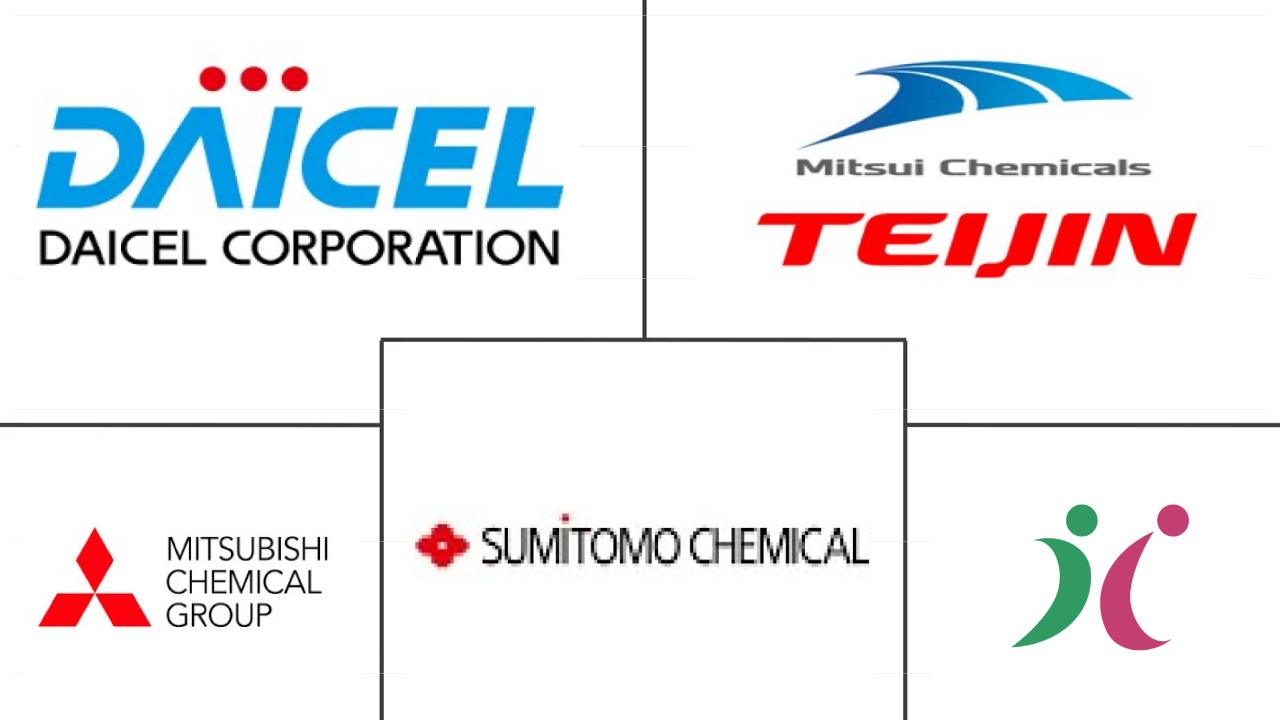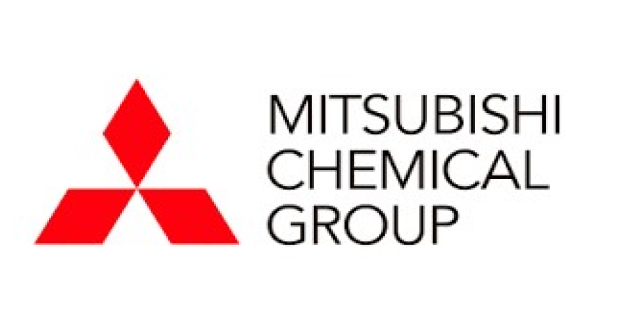Market Size of japan engineering plastics Industry
|
|
Study Period | 2017 - 2029 |
|
|
Market Size (2024) | USD 5.72 Billion |
|
|
Market Size (2029) | USD 7.59 Billion |
|
|
Largest Share by End User Industry | Electrical and Electronics |
|
|
CAGR (2024 - 2029) | 5.80 % |
|
|
Fastest Growing by End User Industry | Electrical and Electronics |
Major Players |
||

|
||
|
*Disclaimer: Major Players sorted in no particular order |
Japan Engineering Plastics Market Analysis
The Japan Engineering Plastics Market size is estimated at 5.72 billion USD in 2024, and is expected to reach 7.59 billion USD by 2029, growing at a CAGR of 5.80% during the forecast period (2024-2029).
5.72 Billion
Market Size in 2024 (USD)
7.59 Billion
Market Size in 2029 (USD)
2.89 %
CAGR (2017-2023)
5.80 %
CAGR (2024-2029)
Largest Market by End-user Industry
31.24 %
value share, Electrical and Electronics, 2023
The electronics segment occupied the highest market share due to the widespread applications of engineering plastics like ABS/SAN, PC, and PA in advanced and smart electrical devices.
Fastest Growing Market by End-user Industry
7.69 %
Projected CAGR, Electrical and Electronics, 2024-2029
The electronics industry is expected to witness the fastest growth due to the rapid adoption of lightweight and high-impact resistant engineering plastics to replace traditional metal parts.
Largest Market by Resin Type
22.53 %
value share, Polycarbonate (PC), 2023
Polycarbonate resin has occupied the largest share owing to its notable usage in electronics as a good electrical insulator with flame-retardant properties. The resin has widespread applications in the automotive and machinery industries.
Fastest Growing Market by Resin Type
9.17 %
Projected CAGR, Liquid Crystal Polymer (LCP), 2024-2029
Owing to the rising demand for high-performance, smaller, and thinner electrical components, LCP resin is projected to witness the fastest growth in the coming years.
Leading Market Player
21.02 %
market share, Mitsubishi Chemical Corporation, 2022

In 2022, with the largest production capacity of around 490 kilotons per year of polymers in Japan, the company held the largest market share. Mitsubishi offers various resins, including PC, PET, PBT, and POM.
The electrical and electronics industry to maintain its dominance in terms of both value and volume
- Engineering plastics have applications ranging from interior wall panels and doors in aerospace to rigid and flexible packaging. In Japan, the engineering plastics market is led by the packaging, electrical and electronics, and automotive industries. Packaging and electrical and electronics industries accounted for around 26.89% and 27.23% of the engineering plastics market volume in 2022.
- The electrical and electronics sector is the largest in the country. For instance, the Japanese electronics industry experienced a 2% Y-o-Y increase in domestic production in 2022, reaching a total of USD 84.34 billion. This growth was mainly attributed to the strong performance of electronic components and devices in exports, the rising usage of electronic components in vehicles, and the increasing demand for electric measuring instruments due to the growth of 5G technology. These factors led to higher consumption of engineering plastics in the country, with volume growth of 1.12% in 2022 compared to the previous year.
- In 2022, the automotive industry accounted for 25.65% of the revenue share, which made it the second largest promising industry in the country. In 2022, the Japanese automotive industry grew at a Y-o-Y rate of 15.15% compared to the previous year. This was mainly due to an increase in vehicle production in the country, which was recorded at 9.41 million units in 2022, 3.49% higher than the previous year.
- Aerospace is the fastest-growing industry in the country in terms of revenue, with a projected CAGR of 7.69%, owing to increased spending in the aerospace industry, which is expected to drive the demand for engineering plastics during the forecast period. Japan's aerospace component production revenue is expected to reach around USD 17 billion by 2029.
Japan Engineering Plastics Industry Segmentation
Aerospace, Automotive, Building and Construction, Electrical and Electronics, Industrial and Machinery, Packaging are covered as segments by End User Industry. Fluoropolymer, Liquid Crystal Polymer (LCP), Polyamide (PA), Polybutylene Terephthalate (PBT), Polycarbonate (PC), Polyether Ether Ketone (PEEK), Polyethylene Terephthalate (PET), Polyimide (PI), Polymethyl Methacrylate (PMMA), Polyoxymethylene (POM), Styrene Copolymers (ABS and SAN) are covered as segments by Resin Type.
- Engineering plastics have applications ranging from interior wall panels and doors in aerospace to rigid and flexible packaging. In Japan, the engineering plastics market is led by the packaging, electrical and electronics, and automotive industries. Packaging and electrical and electronics industries accounted for around 26.89% and 27.23% of the engineering plastics market volume in 2022.
- The electrical and electronics sector is the largest in the country. For instance, the Japanese electronics industry experienced a 2% Y-o-Y increase in domestic production in 2022, reaching a total of USD 84.34 billion. This growth was mainly attributed to the strong performance of electronic components and devices in exports, the rising usage of electronic components in vehicles, and the increasing demand for electric measuring instruments due to the growth of 5G technology. These factors led to higher consumption of engineering plastics in the country, with volume growth of 1.12% in 2022 compared to the previous year.
- In 2022, the automotive industry accounted for 25.65% of the revenue share, which made it the second largest promising industry in the country. In 2022, the Japanese automotive industry grew at a Y-o-Y rate of 15.15% compared to the previous year. This was mainly due to an increase in vehicle production in the country, which was recorded at 9.41 million units in 2022, 3.49% higher than the previous year.
- Aerospace is the fastest-growing industry in the country in terms of revenue, with a projected CAGR of 7.69%, owing to increased spending in the aerospace industry, which is expected to drive the demand for engineering plastics during the forecast period. Japan's aerospace component production revenue is expected to reach around USD 17 billion by 2029.
| End User Industry | |
| Aerospace | |
| Automotive | |
| Building and Construction | |
| Electrical and Electronics | |
| Industrial and Machinery | |
| Packaging | |
| Other End-user Industries |
| Resin Type | ||||||||||
| ||||||||||
| Liquid Crystal Polymer (LCP) | ||||||||||
| ||||||||||
| Polybutylene Terephthalate (PBT) | ||||||||||
| Polycarbonate (PC) | ||||||||||
| Polyether Ether Ketone (PEEK) | ||||||||||
| Polyethylene Terephthalate (PET) | ||||||||||
| Polyimide (PI) | ||||||||||
| Polymethyl Methacrylate (PMMA) | ||||||||||
| Polyoxymethylene (POM) | ||||||||||
| Styrene Copolymers (ABS and SAN) |
Japan Engineering Plastics Market Size Summary
The Japan engineering plastics market is poised for significant growth, driven by its extensive applications across various industries such as packaging, electrical and electronics, and automotive. These sectors are the primary contributors to the market's expansion, with the electrical and electronics industry being the largest. The sector's growth is fueled by the increasing demand for electronic components in vehicles and the rise of 5G technology, which has led to higher consumption of engineering plastics. The automotive industry also plays a crucial role, with a notable increase in vehicle production contributing to the market's revenue. Additionally, the aerospace industry is emerging as a fast-growing sector, with increased spending expected to drive demand for engineering plastics.
The market landscape in Japan is moderately consolidated, with major players like Daicel Corporation, Mitsubishi Chemical Corporation, and Sumitomo Chemical Co., Ltd. dominating the scene. These companies are actively innovating, as seen with AGC Inc.'s introduction of advanced fluoropolymers and Toray Industries' development of high-performance materials for 3D printing. The market's growth trajectory is supported by strategic investments and collaborations, such as the joint venture between Mitsui Chemicals and Teijin Limited to produce biomass polycarbonate resins. Despite challenges like chip shortages and pandemic-related disruptions, the market is set to benefit from government initiatives and industry advancements, ensuring a robust outlook for the coming years.
Japan Engineering Plastics Market Size - Table of Contents
-
1. MARKET SEGMENTATION (includes market size in Value in USD and Volume, Forecasts up to 2029 and analysis of growth prospects)
-
1.1 End User Industry
-
1.1.1 Aerospace
-
1.1.2 Automotive
-
1.1.3 Building and Construction
-
1.1.4 Electrical and Electronics
-
1.1.5 Industrial and Machinery
-
1.1.6 Packaging
-
1.1.7 Other End-user Industries
-
-
1.2 Resin Type
-
1.2.1 Fluoropolymer
-
1.2.1.1 By Sub Resin Type
-
1.2.1.1.1 Ethylenetetrafluoroethylene (ETFE)
-
1.2.1.1.2 Fluorinated Ethylene-propylene (FEP)
-
1.2.1.1.3 Polytetrafluoroethylene (PTFE)
-
1.2.1.1.4 Polyvinylfluoride (PVF)
-
1.2.1.1.5 Polyvinylidene Fluoride (PVDF)
-
1.2.1.1.6 Other Sub Resin Types
-
-
-
1.2.2 Liquid Crystal Polymer (LCP)
-
1.2.3 Polyamide (PA)
-
1.2.3.1 By Sub Resin Type
-
1.2.3.1.1 Aramid
-
1.2.3.1.2 Polyamide (PA) 6
-
1.2.3.1.3 Polyamide (PA) 66
-
1.2.3.1.4 Polyphthalamide
-
-
-
1.2.4 Polybutylene Terephthalate (PBT)
-
1.2.5 Polycarbonate (PC)
-
1.2.6 Polyether Ether Ketone (PEEK)
-
1.2.7 Polyethylene Terephthalate (PET)
-
1.2.8 Polyimide (PI)
-
1.2.9 Polymethyl Methacrylate (PMMA)
-
1.2.10 Polyoxymethylene (POM)
-
1.2.11 Styrene Copolymers (ABS and SAN)
-
-
Japan Engineering Plastics Market Size FAQs
How big is the Japan Engineering Plastics Market?
The Japan Engineering Plastics Market size is expected to reach USD 5.72 billion in 2024 and grow at a CAGR of 5.80% to reach USD 7.59 billion by 2029.
What is the current Japan Engineering Plastics Market size?
In 2024, the Japan Engineering Plastics Market size is expected to reach USD 5.72 billion.

